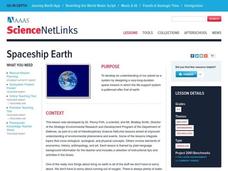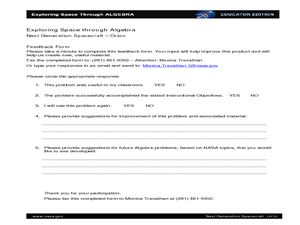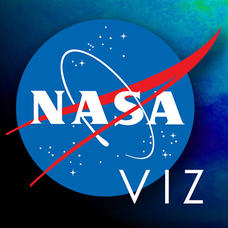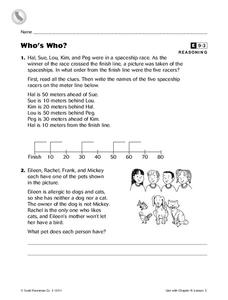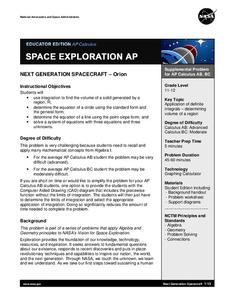CK-12 Foundation
Satellites, Shuttles, and Space Stations: Satellites in Orbit
Blast off! How do satellites, space shuttles, and space stations escape Earth's gravity and achieve orbit? Young astronauts study rocket science (literally) with an interactive lesson. They discover the four main uses for satellites, how...
Mr. E. Science
Manned Space Exploration: From Apollo to Present
How did the manned space mission program progress? The presentation covers American space exploration from the Apollo missions through the International Space Station.
DocsTeach
Apollo-Soyuz: Space Age Detente
The Space Race saw the Soviet Union and the US go from competitors to partners. Scholars read a letter regarding the first docking of the US and Soviet space craft. Young historians also complete a written assignment and participate in...
Curated OER
Space Shuttle Science
Students study the nomenclature, operation and purpose of America's Space Transportation system. They demonstrate how water can be broken down into its component gases of hydrogen and oxygen by electrolysis. They construct and use the...
Curated OER
Spaceship Earth
Students develop an understanding of our planet as a system by designing a very-long-duration space mission in which the life-support system is patterned after that of earth.
American Museum of Natural History
Field Trip: Space Flight
Take a virtual trip to infinity and beyond. Pupils watch a space visualization that leaves Earth and heads to the ISS and then follows the Apollo missions to the moon. Scholars view detailed images of the space station and its different...
Mr. E. Science
Manned Spaced Exploration: From Start to Gemini
Seven percent of Americans believe the moon landing was staged. The presentation covers manned space exploration from the beginning of the space race through the Gemini missions. The lesson is the 23rd in a set of 26.
NASA
Next Generation Spacecraft - Orion
Emergine space engineers discover the area of complex geometric shapes. They find that, just as a spacecraft is composed of many smaller parts, so can polygons be broken into smaller shapes.
NASA
Space Images
As technology advances, so does our understanding of the universe around us. Thanks to the Hubble Telescope, Mars rovers, and other high-resolution cameras, there are amazing photographs of celestial bodies, planets, comets, and more...
Messenger Education
Give Me a Boost—How Gravity Assists Aid Space Exploration
The propellant needed for space explorations runs in the thousands, while paying to get the craft into orbit costs millions! In the second installment of three, two activities explore laws of conservation of energy and momentum. Using...
Curated OER
Return to the Moon
Young scholars react to statements about space exploration, then read a news article about plans to resume manned flights to the moon. In this space science and current events lesson, the teacher introduces the article with a discussion...
Curated OER
Women In Space: Sally Ride
Second graders explore the life and accomplishments of Sally Ride, the first American woman in space. Through reading and discussion, they recall details from Sally Ride's life.
Curated OER
Doctor Mae C. Jemison - First African American Woman in Space
Seventh graders trace and analyze the life of Doctor Mae C. Jemison and the circumstances that enabled Dr. Jemison to achieve her goal of becoming an astronaut. They explore the role of NASA in the development of America's Space Shuttle...
NASA
NASA Visualization Explorer
Read some of the most up-to-date information available from NASA's current Earth and space research! Along with showcased stories, you will find computer animations and satellite images that help you to view what humans cannot see with...
Curated OER
Who's Who?
In this reasoning worksheet, 3rd graders read and analyze two sets of clues to figure out where 6 people will set on a spaceship in the first set of clues and which pet belongs to which person in the second set of clues.
John F. Kennedy Library Foundation
JFK Challenge
And so, my fellow Americans: ask not what your country can do for you—ask what you can do for your country. And so begins your invigorating, innovative learning experience in the JFK Challenge app! Learners choose from two "missions" and...
Curated OER
Designing a Crew Exploration Vehicle
Take your class on an out-of-this-world adventure with this fun engineering design lesson. Working in small groups, young scientists design, build, and test crew exploration vehicles using some creativity, teamwork, and an assortment of...
Curated OER
Christa McAuliffe: Teacher in Space
Students study the life of Christa McAuliffe who was on the Challenger space shuttle lost their lives when the ship exploded.
American Museum of Natural History
A Closer Look at Mars
A website looks at how we know so much about Mars—telescopes, robots, and spacecraft—and the search for martian life. Following the informational text are three questions that quiz pupils about possible life on Mars.
Curated OER
NEXT GENERATION SPACECRAFT-Orion
Students investigate the volume of a solid. In this calculus lesson, students use integration to find the volume of a solid generated by a region, the Orion crew module.
Curated OER
Behind the Mission to Mercury
Learners read an E-Sheet about the Mission to Mercury. They follow a variety of worksheets and on-line activities that follow the E-Sheet. They discuss several different scenarios regarding space exploration. They analyze one of the...
Teach Engineering
Get Me Off This Planet
What do Newton's Laws have to do with getting from Earth to Mars?The activities in this resource show how Newton's Laws work with rockets to get them into space. Background information includes facts about orbits and how orbits are used...
Curated OER
Build a Space Shuttle
Students explore the concept of space. In this space lesson, students pretend to be aerospace engineers. Students build space ships out of cardboard tubes. Students discuss what aerospace engineers do. Students model their space ships...
Curated OER
Space-Age Experiments
Students evaluate the notion of aging by reviewing some of the studies that occurred on John Glenn's space shuttle mission.






